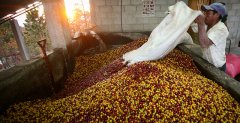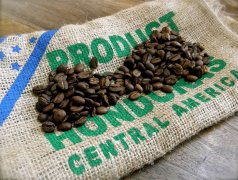Introduction of a new variety developed in Honduras-Urguado small farmer Pacas+IH90 coffee from St. Vincent's processing plant

Professional barista communication, please pay attention to coffee workshop (Weixin Official Accounts cafe_style)
Name: San Vincent, Honduras Treatment Plant Ecuador Small Farmers Pacas + IH90 Variety Wash
(Honduras San Vicente Edgardo Tinoco Pacas + IH90)
Location: Pena Blanca, Santa Barbara
Treatment plant: Beneficio San Vicente
Variety: Pacas + IH90 (one of the new varieties developed by the Honduran Coffee Association)
Grade: SHG
Altitude: 1,300 to 1,500 meters
Certification: N/A
Flavor Features: Almond, Cedar, Dark Chocolate, Dark Fruit,
Plum caramel, thick texture.

Introduction:
Coffee cultivation began in Honduras in 1804, and there are now 280,000 hectares of coffee plantations,
Most of them are coffee farmers, and their coffee plantation area is mostly less than 3.5 hectares.
Coffee farmers account for 60% of coffee production in hong kong. Coffee production in Honduras in 2011
Surpassing Guatemala, it became the second largest exporter of washed arabica beans in the world in 2012.
After Brazil. It is now the seventh largest producer in the world. Coffee farming is not like banana plantations.
Owned by two American oligarchs, Honduran coffee farmers are 92 percent small individuals.
Coffee is associated with 12.5 percent of the population of eight million workers, so coffee is the most common coffee in Honduras.
It is a very important crop. In the coffee garden, coffee farmers harvest red fruits, wash them, ferment them, and add
According to the market demand, different taste needs of consumers are met by grading. Honduras
Three million bags of coffee are harvested every year to provide good quality coffee with unique coffee flavors
The quantity is large and the quality is excellent. Now it has become the largest producer in Central America and the top ten in the world.
Coffee exporting countries. The coffee industry in Honduras involves hundreds of thousands of families and livelihoods across the country.
It provides one million jobs for Honduras 'economically important agriculture.
Honduras coffee relatively large production areas, throughout the western and southern production areas have Copan, Opalaca
Montecillos, Comayagua, Agalta, El Paraico and other six major production areas
The average planting height is more than meters above sea level. Coffee is 100 percent.
Arabica species, 69% HG, 12% SHG, 19% CS. Mainly coffee growers.
Varieties include Typica, Bourbon, Caturra, Villa Sarchi and Lempira.
Honduran coffee has always maintained high quality and its prices are among the most competitive in Central America.
Small, round, slightly pale green coffee, belongs to mild fruit acid, taste full slightly sweet,
Suitable as a blend or single-serve coffee, suitable for medium to deep roasting
It is mainly exported to USA, Germany and Japan. Honduras is already the first largest country in Central America.
Coffee producing countries, production has been increasing in recent years, in 2012 due to international coffee prices good,
Coffee production for the year exceeded 5 million bags in 2010, with a significant increase in production volume and continuous improvement in quality.
The Santa Barbara region is located in the west of Honduras.
It's northwest of Lake Yojoa, which has developed into Honduras over the last few years.
Famous coffee producing area. And this area is from a famous agronomist Mr. Angel Arturo Paz,
He owns a post-processing facility at San Vicente, west of Lake Yojoa.
Peña Blanca, a town in the northern Santa Barbara region,
He has been a long-time winner of the Honduras COE (Cup of Excellence). St. Vincent's treatment plant
Acquire the surrounding towns of El Cielito, Las Flores and El Cedral
Each location has at least 35 families and one school).
Although it is often difficult to isolate these smallholder output batches because of their small numbers,
But the coffee produced in these areas has always been amazing with its high sweetness and fruity tonality.
San Vicente is a family-run treatment plant known locally.
Through projects to help farmers upgrade planting techniques and improve production equipment, efforts have been made to
The Group is closely connected with producers and strictly controls each batch of products by coffee cup test.
This lot St. Vincent's treatment plant tropical rain forest certification SHG is the treatment plant acquired around the area
Coffee smallholders combine production and marketing because each coffee smallholder grows an average of
1~2 hectares, the number of kilograms of green coffee beans produced cannot be sold separately, only combined
Marketing in batches together, a bit like a production cooperative or coffee production team.
This batch of Edgardo Tinoco from San Vicente, Ecuador
Nearby small villages Edgardo Tinoco, small coffee farmers aggregate, general smallholder acreage
Small, can not handle raw beans sold separately, can only be sold to the processing plant concentrated quantity sold together.
Flavor characteristics: almond, cedar, dark chocolate, dark fruit, plum caramel, thick palate.
Important Notice :
前街咖啡 FrontStreet Coffee has moved to new addredd:
FrontStreet Coffee Address: 315,Donghua East Road,GuangZhou
Tel:020 38364473
- Prev

Coffee Flavor characteristics and Origin Information of Saint Vincent processing Plant in Honduras, the largest coffee producer in Central America
For the exchange of professional baristas, please follow the coffee workshop (official Wechat account cafe_style) Product name: San Vincent processing Plant, Honduras Flower Mero small Farmer washing (Honduras San Vicente Juan Contreras Miraflores) production area: Santa Barbara (Santa Barbara) Pena Blanca small town processing plant: St. Vincent processing Plant (Beneficio San)
- Next

Introduction to the flavor characteristics of tropical rain forest certified coffee from COE Cup Changshengjun, Honduras-Saint Vincent treatment Plant
For the exchange of professional baristas, please follow the coffee workshop (Wechat official account cafe_style) Product name: Honduras St. Vincent processing Plant Tropical Rainforest Certification SHG (Honduras San Vicente Rain Forest SHG) production area: Santa Barbara (Santa Barbara) Pena Blanca Town processing Plant: St. Vincent processing Plant (Beneficio San Vicente)
Related
- Does Rose Summer choose Blue, Green or Red? Detailed explanation of Rose Summer Coffee plots and Classification in Panamanian Jade Manor
- What is the difference between the origin, producing area, processing plant, cooperative and manor of coffee beans?
- How fine does the espresso powder fit? how to grind the espresso?
- Sca coffee roasting degree color card coffee roasting degree 8 roasting color values what do you mean?
- The practice of lattes: how to make lattes at home
- Introduction to Indonesian Fine Coffee beans-- Java Coffee producing area of Indonesian Arabica Coffee
- How much will the flavor of light and medium roasted rose summer be expressed? What baking level is rose summer suitable for?
- Introduction to the characteristics of washing, sun-drying or wet-planing coffee commonly used in Mantenin, Indonesia
- Price characteristics of Arabica Coffee Bean Starbucks introduction to Manning Coffee Bean Taste producing area Variety Manor
- What is the authentic Yega flavor? What are the flavor characteristics of the really excellent Yejasuffi coffee beans?

